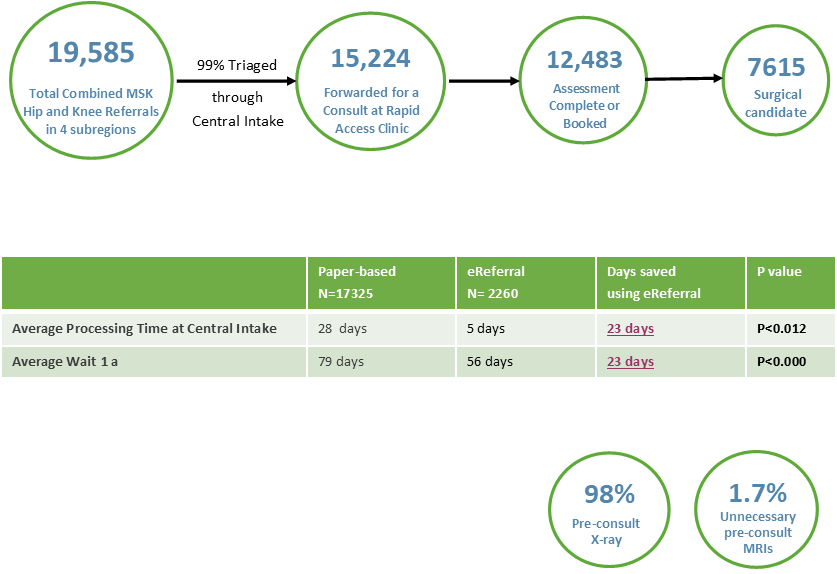Benefits of eReferral and MSK Model of Care
In Canada, 36% of the population suffers from a Musculoskeletal (MSK) disorder.1 Currently, patients experience a long wait time to receive a consult from an orthopedic specialist.2 Evidence has shown that approximately 40% of MSK patients can be managed conservatively with no surgery.3 Moreover, studies have shown that Magnetic Resonance Imaging (MRI) scans are overused for various MSK ailments such as hip, knee, and back pain.4,5 However, diagnostic imaging guidelines indicate that the value of MRI scans for MSK patients suffering from osteoarthritis is limited, and an X ray is more suitable to direct the treatment plan.6,7 Unnecessary referrals for MRI and surgical consults are contributors to the long wait times. In Ontario, patients could wait several months to see an orthopedic specialist.8
To support appropriate and timely access to MSK specialty care, the System Coordinated Access (SCA) Program has deployed electronic referral (Ocean eReferrals) in 3 of the 5 Ontario Health regions across the province (West, East, and North), in 2018. In this model, referrals are sent from primary care offices to central intake, where referrals are reviewed for missing information and adequately triaged according to the patients’ needs.9,10 At rapid access clinics, patients are assessed by advanced practice physiotherapists to determine if a surgical consult is required and to provide enhanced options for conservative treatment, when needed.11 Only patients in need of a surgical consult are referred to surgeons.11
Key takeaways
The use of an electronic referral solution that incorporates decision-support standards to send MSK referrals saves time processing referrals at central intake, reduces wait time for assessments and supports efforts to reduce the ordering of unnecessary diagnostic imaging.
The Ocean eReferral network uses eforms, many of which incorporate evidence-based clinical guidelines. These forms ensure referral information is complete prior to sending and promote appropriate diagnostic imaging ordering for patients. Also, the referral in-application messaging and status tracking features make communication, gathering of information, and tracking referrals easier and faster across sites. The eReferral solution and the implementation of the MSK model are designed to reduce the long wait time for MSK patients to receive appropriate care.
Analysis of quantitative MSK hip and knee Ocean referral data (electronic and paper-based referrals processed and triaged at central intake through the system) from September 2018 to the end of October 2019 across four subregions (WW, ESC, NE, and SE) was conducted. A comparison of indicators for efficiency by the method of referral was done for:
- Processing time at central intake— The date the referral was created till the date it was forwarded to rapid access clinics
- Wait 1a time—The date of receipt of referral at central intake until the assessment date at rapid access clinics
- Proportion of images ordered for knee pain osteoarthritis patients ≥55 years
- Appropriateness of ordered MRI scans
With eReferral, I love that I don’t have to call to confirm the referral was received and that I don’t have to call for status updates.
Office administrative staff, FHT office
North East LHIN
Hope we can use Ocean eReferral for all referrals to specialist services.
Clinical Director, FHT office
South East LHIN
MSK Hip and Knee Referrals Processed through Ocean eReferral System September 2018 – October 2019 across 4 subregions

A highlight of the potential benefits of following a comprehensive model of care within the referral practice
Of all the processed MSK referrals, 7,125 were for knee pain osteoarthritis patients ≥55 years. Based on the University Health Network (UHN) guidelines12 and MSK model consult outcome, the data illustrates a high proportion of X ray orders and low proportion of unnecessary MRIs as recommended by diagnostic imaging guidelines.12
- 6998 referrals had an X ray ordered at the point of referral
- Only 118 MRI scans were ordered unnecessarily pre-consult
About the SCA Program
The System Coordinated Access (SCA) Program was originally initiated to support the development and adoption of electronic referral in the Waterloo Wellington region. As a result of an investment by the Ontario Government, the program, in collaboration with the Think Research Consortium (Think Research, CognisantMD and Centre for Effective Practice), has now expanded to support the implementation of Ocean eReferrals to 3 of the 5 Ontario Health regions across the province (West, East and North).
eReferral replaces paper-based faxes with electronic referrals. Through a secure integration with electronic medical records (EMRs), referrals are sent, tracked and updated right from the patient’s electronic chart. The local SCA deployment teams provide training, solution set-up and support.
- Barua B, Ren F. Waiting your turn: Wait times for health care in Canada. Fraser Institute 2016 report. 2. Barua, B., & Fathers, F. (2014). Waiting your turn: Wait times for health care in Canada, 2014 report. Fraser Institute.
- Barua, B., & Fathers, F. (2014). Waiting your turn: Wait times for health care in Canada, 2014 report. Fraser Institute.
- Primary Care Clinics. SW MSK Rapid Access Clinics webinar. March 2018.
- Bradley MP, Tung G, Green A. Overutilization of shoulder magnetic resonance imaging as a diagnostic screening tool in patients with chronic shoulder pain. J Shoulder Elbow Surg 2005;14:233-7.
- Roberts TT, Singer N, Hushmendy S, et al. MRI for the evaluation of knee pain: comparison of ordering practices of primary care physicians and orthopaedic surgeons. J Bone Joint Surg Am 2015;97: 709-14.
- Englund M, Guermazi A, Gale D, et al. Incidental meniscal findings on knee MRI in middle-aged and elderly persons. N Engl J Med 2008;359:1108-15.
- Englund M. Meniscal tear–a feature of osteoarthritis. Acta Orthopaedica Scandinavica 2004;75(sup 312):1-45.
- Liddy C, Nawar N, Moroz I, et al. Understanding Patient Referral Wait Times for Specialty Care in Ontario: A Retrospective Chart Audit. HealthCare Policy. 2018; 13 (3):59-69
- Hosking J, Gibson C. Impact of the single point of access referral system to reduce waiting times and improve clinical outcomes in an assistive technology service. Journal of Medical Engineering and technology 2016; 40(5):265-269
- Mackay C, Canizares M, Davis A, Badley E. Health Care Utilization for Musculoskeletal Disorders. Arthritis Care & Novak K, Veldhuyzed S, Zanten V, et al. Improving Access in Gastroenterology: The Single Point of Entry Model for Referrals. Can J Gasterenterol 2013; 27(11): 633-635
- ARTIC. MSK Rapid Access Clinics. Engagement with Key Associations.2018.
- DI App. Imaging Pathway for UHN. 2018. http://pathways.coralimaging.ca/about.php
Interested in learning more?
Interested in partnering with us or learning more about
what we can offer you? Please reach out here.
Get the latest resources and insights
-

Why eReferral is the Obvious Choice: Modernizing Healthcare Communication
eReferral is improving both the clinician and patient experience. This overview highlights the benefits of…
-

Upcoming Webinar: Optimizing Primary Care Efficiency Through IHP Integration and Team Collaboration
Our next webinar is happening next week! Co-hosted by Julia Hutton, NP and Teresa Wetselaar,…
-

eReferral supports mental health and addictions in Ontario
Key takeaways Electronic referral (eReferral) for Mental Health & Addictions (MH&A) has expanded across Ontario,…
-

Prevention over reaction: Shield’s vision for cyber education in healthcare
In Canada’s digital healthcare ecosystem, cyber threats are no longer hypothetical, they’re happening now, and…